
Developing a custom LMS can be a highly effective solution for organizations looking to provide tailored e-learning experiences. Custom LMS software can help the organizations to align the LMS platform with their specific training goals, branding, and user experience. A custom LMS allows to implement unique features and functionalities that meet the client’s specific needs.
According to Valuates reports, the corporate learning management system market size is projected to reach $7570 million by 2026 at CAGR 22.8%. Instant access to knowledge and effectiveness of employee training are leading more and more SMBs and large companies to adopt learning management systems.
In this article, we’ll talk about the problems that LMS customization solves, the latest development trends, how to develop LMS, and how to choose the right software provider.
Does custom LMS development bring any business value for SMBs and large companies?
When businesses are faced with low employee engagement, new talent is hired in hope that they will do better. However, this solution is unproductive. It costs businesses $4,129 on average to hire new talent, and then around $986 to onboard the new hire. Do the math, and you get a total loss of over $5,000 each time an employee walks out the door. A corporate LMS helps companies to get out of the hiring-firing vicious circle, boost employee skills, and grow brand ambassadors. Further LMS benefits:
- Improved business and learner performance. Personal advancements of your employees translate directly into the advancement of your business. A corporate LMS can help employees with onboarding, mentorship, compliance education, and corporate culture training. For example, a custom LMS can improve your personnel’s soft skills: communication, conflict solving, or decision-making.
- Increased employee retention rate. Employers might fear losing talent when they upgrade their skills and decide to leave for a new job opportunity. However, a custom LMS not only trains employees, but also cultivates loyalty towards their current job place.
- Flexibility and independence from any learning environment. Building your own LMS allows employees to access learning material anywhere—at home, in a café, on the road, in the park, or while on sick leave. Today’s generation strives for educational flexibility, and giving them full freedom in terms of time and location is a perfect way to keep them motivated and engaged.
- Storing all the data in one place. Data centralization ensures that access to training materials, job guidelines, company policies, documents, or personal notes is regulated. Finally, a comprehensive knowledge base will help you analyze an employee's progress. Team leaders can see if an employee is ready for a specific project or if they need additional training sessions.
- Cost savings. Learning management system development is a one-time expenditure, which certainly pays off in the future. LMS customization for corporate learning needs you minimize the time and resources spent on training employees and hiring coaches. A custom LMS allows you to conduct employee training without any additional expenses.
What are the trends in LMS development for corporate needs?
We’ve singled out five most important EdTech trends in 2023 that are actively used in corporate LMS development.
Gamification
Gamification turns mundane learning modules into game-like exercises, allowing for information to be embedded in the learner’s long-term memory. It works by lowering mental barriers that prevent employees from absorbing new information, simultaneously boosting productivity and increasing employee engagement. Most importantly, gamification enhances retention of new knowledge.
Read also: How to Make Educational Games That Engage Your Players
For example, the Docebo LMS provides simulators for employee onboarding. The platform offers a combination of informal and formal training programs in a virtual and collaborative environment and with a varied third-party course library.
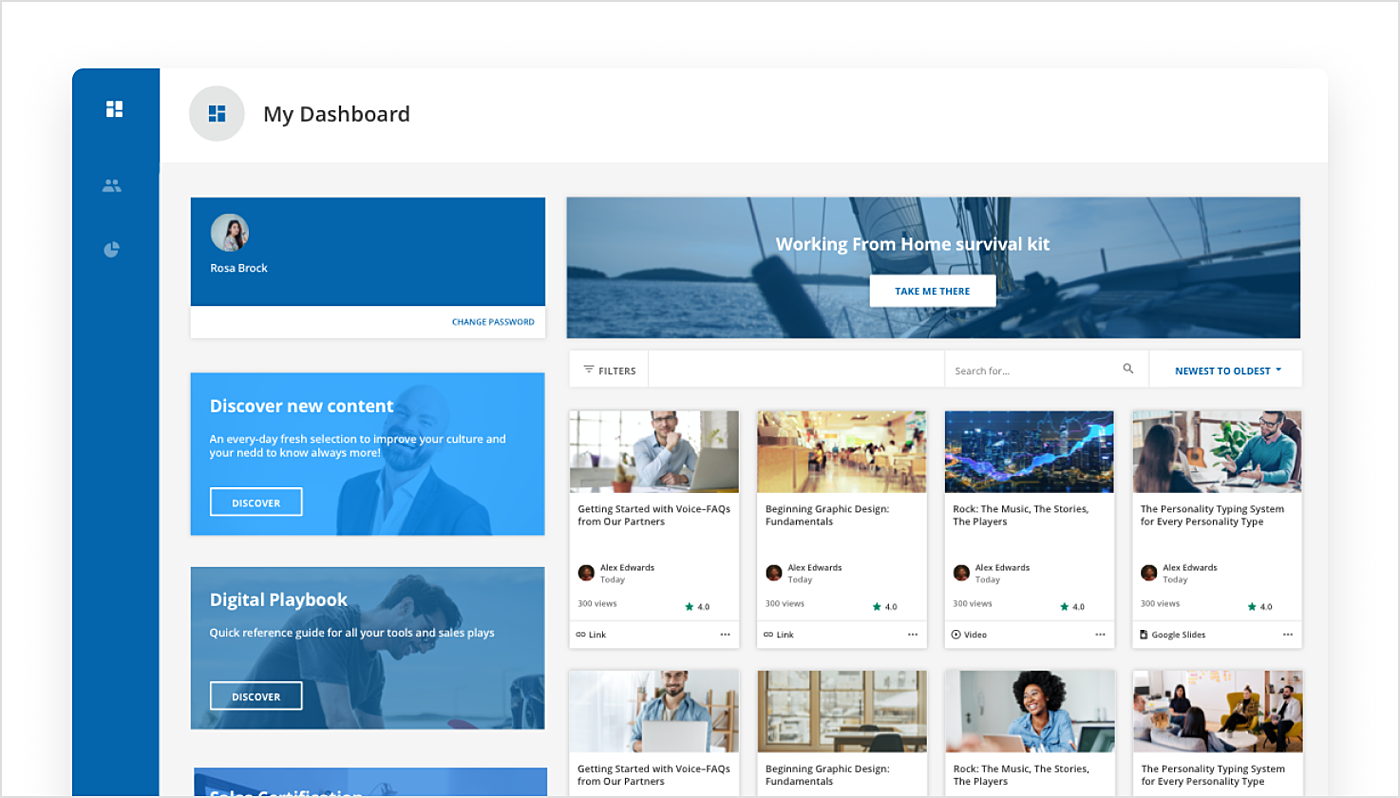
Source: Docebo LMS
Mobile-friendly LMS
A mobile-friendly learning management system design results in higher retention of learned content and higher completion rates. Some of the benefits of a mobile-friendly solution include:
- Higher retention rates
- Higher completion rates
- Higher engagement
- Social learning
- Flexibility
- Cost savings on classrooms and printed course materials.
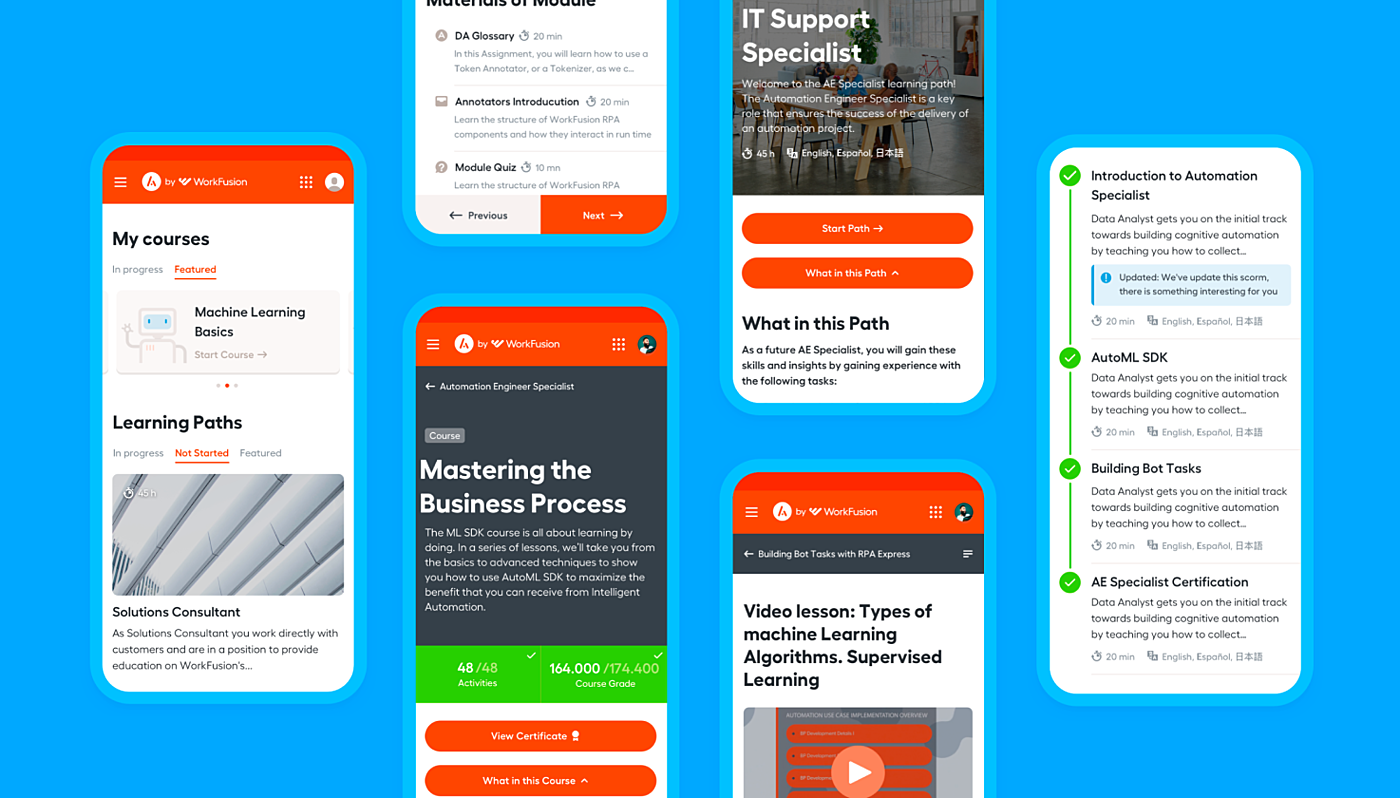
Source: Agente case
Microlearning
Microlearning is based on short-term lessons, projects, or coursework designed to provide students with small bits of information. Instead of trying to teach a student about a broad subject all at once, the topic can be broken down into smaller projects.
A corporate microlearning platform gives employees an ability to gather information in “bite-sized” forms, which can help them to absorb it more effectively.
Microlearning can be done on the go, and in a variety of ways. Employees can receive smaller lessons that help them advance towards their training goals and acquire new skills. The forms of learning include emails, online posts, short multimedia videos, or even short chat sessions.

Source: Learn App
Big Data and Analytics
Big Data is one of the biggest issues in the corporate sphere due to the astounding amount of information that needs structuring, and that’s where LMS comes into play. Its reports on various metrics will help you develop a more effective learning strategy. The key metrics are:
- Online employee performance and progress. The LMS analyzes these metrics and gives valuable insight into learning experience, behaviors, and proficiency.
- Reports on the completion rates. They allow you to see whether your learners are actually completing professional courses and how long it takes them to finish each task or module. Work with Big Data gives you a good indication of LMS effectiveness.
- Assessment scores. These metrics will provide you with measurable data that you can use to improve your course design. If the percentage of passes is high, your eLearning course is on target. Assessment scores also give you the power to identify the learners' strengths and weaknesses to be used to create personal learning paths.
- Peer-based feedback. Although it’s more difficult to track, the data offers a unique perspective of learning behaviors and performance. Social media groups, eLearning forums, online group collaboration projects, and learner-generated content are great sources of peer-based feedback.
- Online surveys. It’s an opportunity to see learners’ honest opinions and recommendations. You can use this data to modify your LMS design.
AR/VR
Integrating VR and AR technologies into LMSs gives businesses a fully-integrated learning experience and an opportunity to measure the capability of employees, and to identify where improvements can be made.
When AR/VR is integrated into an LMS, you have the opportunity to monitor employees’ performance mentally, physically, and emotionally, with no risk involved.
Employees, in their turn, understand their strengths and weaknesses, and are exposed to situations they can use to develop skills much quicker. AR/VR technology helps to create a complicated training project that needs extensive practice. Other AR/VR integration benefits include:
- Low risk factor and simplified complex procedures
- Better understanding and memory recall
- Enhanced user engagement
- Simulated real-life scenarios
For example, VirtualSpeech has created a hybrid LMS, in which employees can learn fundamental business skills through traditional online classes, and practice what they have learned in realistic VR training scenarios and simulations.
The app works with VR headsets, such as Merge VR, Google Cardboard, and Blitawolf VR.
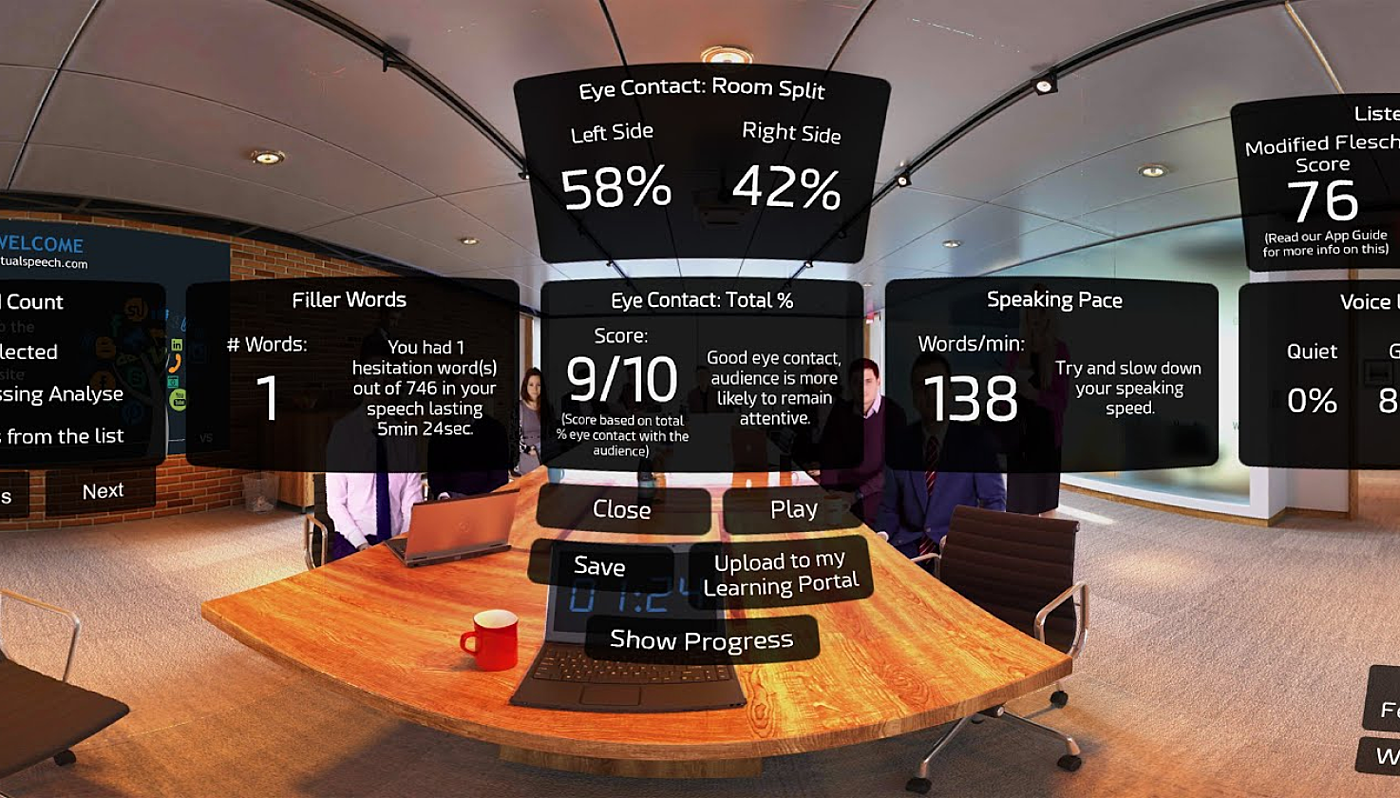
Source: VirtualSpeech app. You can choose job interviews with different companies.
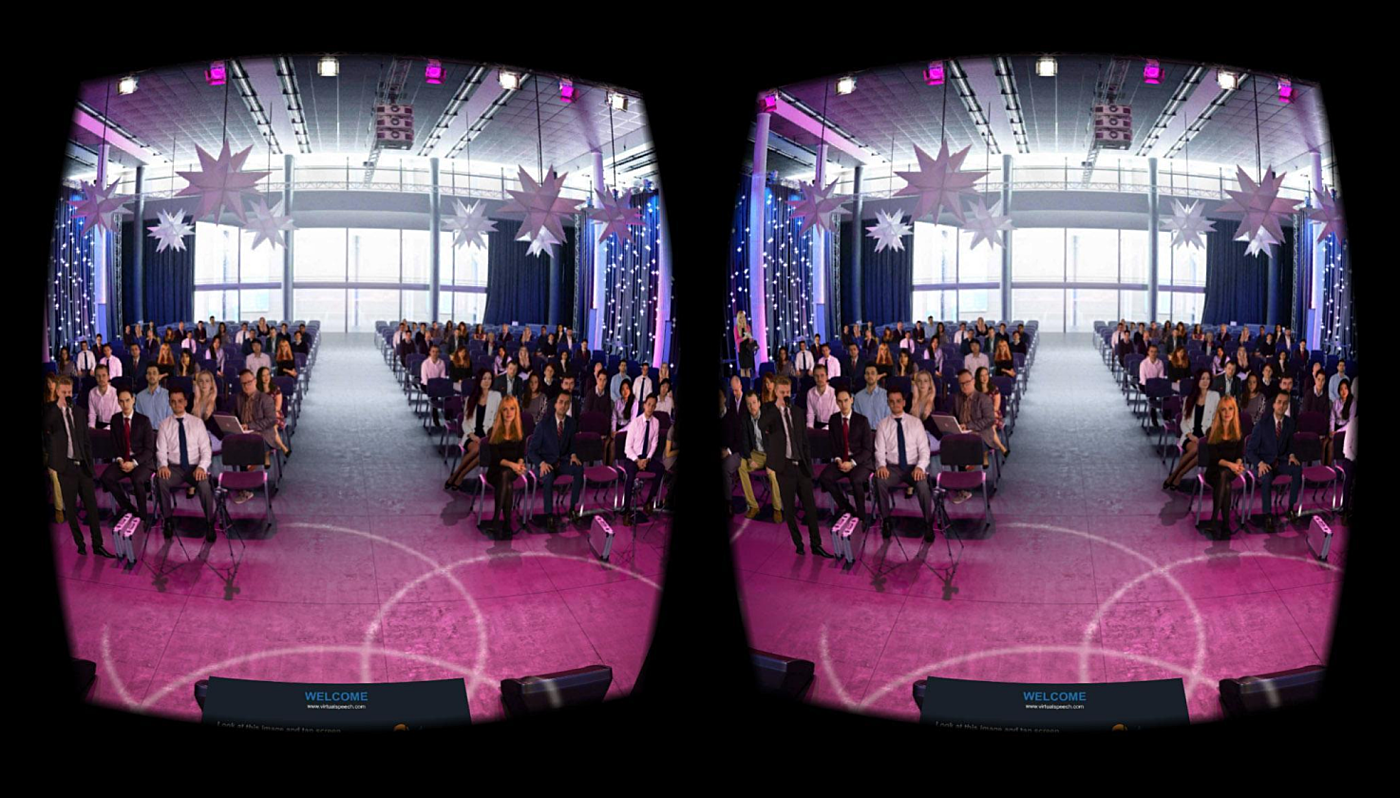
Source: VirtualSpeech
Core Features of Learning Management Systems
While different LMSs may have varying features, there are some core features that are common to most of them. These are the core features:
- Course management: allows to create and organize courses, set enrollment criteria, and manage learner progress.
- Content management: enables the creation of learning materials such as documents, videos, and quizzes.
- Assessment and grading tools: allow to create tests and assignments, grade them, and provide feedback to learners.
- Collaboration tools: facilitate communication and interaction between learners and instructors through such functionality as forums, chat rooms, and virtual classrooms.
- Reporting and analytics: provide insights into learner performance and engagement metrics that can help to improve the learning experience.
A sneak peek at the custom LMS development process
Here is the guide how to build an LMS from scratch:
Building an MVP
Why does one need an MVP for LMS? It is a crucial step for testing your ideas on real users at minimal cost. Otherwise, you might end up spending all your resources on a product that no one will be able to use.
With LMS MVP, you get a working product with basic features launched on the target market so that you can receive user feedback. This feedback will then be used to build a full-fledged solution that enables users achieve their goals in less time and with more efficiency.
Before you start building your own LMS system, it’s important to define your target audience (employees in your case), the specific problems that the corporate LMS will solve, and how this solution can automate current learning processes.
Usually an MVP also implies a design discovery stage where user stories, user personas, user flows, information architecture, and low fidelity wireframes are created. After that, the actual UX/UI design takes place with UX wireframing, prototyping, and high-fidelity UI mockups.
The list of must-have learning management features for your platform may include:
- Content management. The main objective of any LMS for business is enhancing employees’ skill sets. This functionality helps trainers to create various forms of content: courses, quizzes, or assignments. It also includes defining user roles: learners, teachers, and administrators.
- Collaboration tools. They allow users to quickly and easily share and collaborate on files like written documents, videos, and images. It’s important to enable simultaneous collaboration in the real-time-mode.
- Skill and progress tracking. This feature helps employees to learn at their own pace, while their performance will be automatically measured. It is also useful when choosing a relevant specialist to the client project. A corporate LMS can have a built-in matchmaking mechanism to help you accelerate the search process.
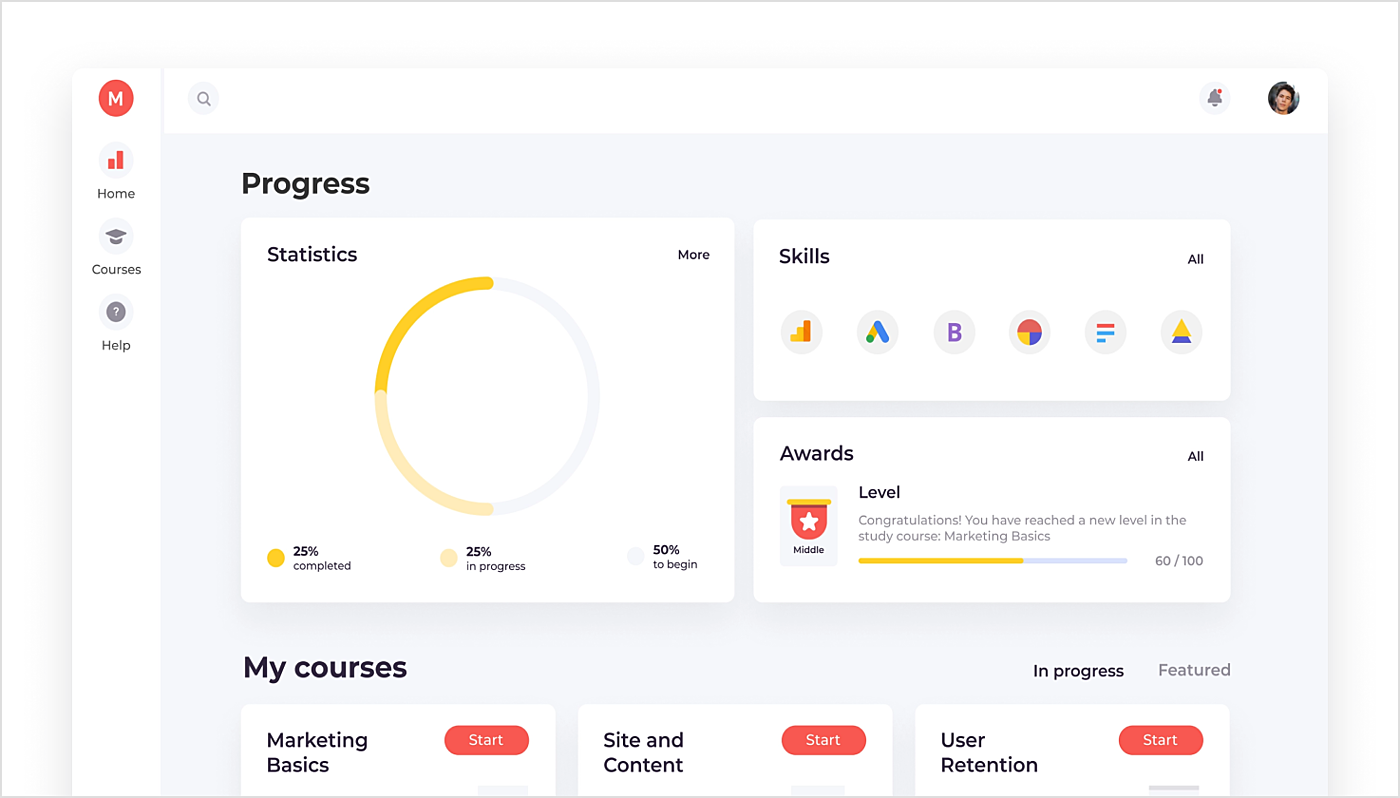
Source: Agente case - Analytics. It provides detailed reports on the progress of learners, their achievements, and gives overall statistics of the entire class or at an individual level.
- Integration with the third-party and internal resources. For example, your corporate LMS can have integrated HRIS (HR systems), ERP, CRM, and PM tools, if needed.
Full-fledged LMS
The MVP can be tested on a specific department to understand how the rest of employees will respond to it. When alpha and beta testing is over, and the LMS developers have received feedback from the first users, it’s time to make the product more convenient and add the features that will make learning more personalized.
LMS Design
Tweaking LMS design. This is designing each component of your LMS with usability in mind. It means creating a hierarchy of actions you need users to take, ranking them from essential to non-essential, and using prominent buttons, links, and clean copy to direct people to them.
UX/UI Design can be a part of the discovery stage, but if, after MVP the design needs upgrading, then your project designers should update UX wireframes, prototypes, and high-fidelity UI mockups
LMS Development
- Mobile learning. It’s not just a trend; it’s a valuable feature. Mobile learning facilities should be included in the architecture of the LMS at the planning stage. Users should be able to take the courses from their preferred devices. This feature is also useful for distributed teams.
- Video conferencing. It allows one-on-one and one-to-many interaction with the instructor. Emails and messaging boards do, too, but face-to-face interaction delivers better understanding.
- Social learning. Community experience enhances the overall learning process. If Student A has a question and can post it in the forum, there’s a chance that Student B knows the answer and can tell him how to overcome the issue. Thus, the pressure on the trainer is reduced.
- Gamification. Gamified features don't make the subject matter of the course easier. However, they do make the learning process less of a routine. Gamification keeps learners engaged, and it streamlines module coverage.
QA
When the LMS customization is ready, the QA team runs multiple tests to ensure that when it goes live it is bug-free and operates smoothly. There are likely to be several testing cycles to launch a high-quality product. This means that when bugs are detected, the QA team sends bug reports to the developers who, in turn, fix the issues.
Deployment
At this stage the corporate LMS is officially launched thanks to CI/CD practices. Now your employees can use it and share their feedback on how the platform meets their learning needs and on any additional tweaking that should be made.
Support
Even after a thorough QA testing, some bug fixes and updates may be required. The LMS may also need additional features you haven’t thought of at previous stages or you may need to remove the useless ones. This stage also covers employee training on how to use the platform.
Scaling eLearning ecosystem
These are the features that are not obligatory but will make your LMS system a cutting-edge one.
- Asynchronous and synchronous learning. Asynchronous learning lets employees access course materials at multiple times and locations. The main benefit is that users can learn at their own convenience. Synchronous learning requires students to learn at specific times (online or in a physical classroom). It can foster collaboration between employees.
- Virtual personal assistant (a chatbot). A personal assistant is available at every step of the learning path and helps the learner to complete the course step by step. It also assists mentors by lowering the burden when explaining the same things to multiple learners and checking their homework regularly.

Source: Freepik - Calendar. This feature allows employees to schedule important activities like conferences, webinars, and tests allowing them to complete those that are prioritized.

Source: VEDAMO
LMS Development Challenges and Solutions
Developing a Learning Management System can have some challenges. One common challenge is ensuring that the LMS has a user-friendly and intuitive interface for both administrators and learners. It is important to create a system that is easy to navigate and understand, with clear instructions and a logical layout.
Another challenge is integrating the LMS with existing systems and technologies. This requires careful planning and coordination to ensure seamless integration and data exchange.
By addressing these challenges, a well-designed and effective LMS can be developed to enhance learning experience.
How to choose an IT partner for LMS development?
Before finalizing the company you’ll delegate LMS software development services to, there are a few things that you must consider when you hire LMS developers:
- Transparency and ease of communication. LMS developers should ensure that they are always ready to respond to the customer’s requests. Learn their time zone and if it affects your project release make sure that they will be able to keep you updated at every step of development.
- Experience related to eLearning domain. An LMS software development company should have similar projects in its portfolio that demonstrate prior experience.
- Support. LMS development consultants can also train your staff to manage day-to-day backups and maintenance. It’s a great bonus when developers give guarantee after the product delivery that may last from several months to half a year.
- Reviews. Research reviews on the internet paying special attention to the eLearning projects.
Agente experience
Automation Academy by Workfusion
One of our key competences is e-learning management software development. One of our recent projects is Automation Academy by Workfusion. It’s an online education platform that teaches intelligent automation and RPA for enterprises, SMEs, as well as engineers.

Source: Agente case

Source: Agente case
We organized a dedicated team of PM and UX/UI designers to analyze project requirements. Together with the customer, they decided to re-build the information architecture and user flow and to add a fresh touch to the interface by drawing custom illustrations.
Internal employee training system for Cisco
Another LMS case was the development of an LMS MVP for CISCO. They wanted a system for internal employee training about cultural differences between colleagues. We provided software development and quality assurance.

Source: Agente case
The final product includes an extensive range of features including content management, user management, analytical tools (leaderboards, checking progress), corporate event creation, and video courses with playback capabilities.
What factors influence the LMS cost?
There is no one-size-fits-all policy considering custom learning management system cost. It depends on several factors:
- Implementation. This involves the number of features a customer wants to implement: software customization, data migration, and integration with other software (for example, enterprise resource planning systems).
- Support. Basic support (knowledge base, email support, etc.) is included in the price. However, LMS developers may offer plans that include advanced support, such as access to a dedicated customer service manager or priority support.
- Maintenance. Just to create custom LMS software is not enough. It requires ongoing maintenance, such as patches, updates, and upgrades. This is generally included with subscription pricing, but not with licensing fees.
If you want to build your own LMS system from scratch with a wide set of features, it could take about 200 to 1000 hours. The process includes a lot of communication about the learning management system requirements, architecture, design, and arrangement of features, QA principles, and deployment process. One more factor to influence the final cost is maintenance after the product launch.
If you choose to customize a ready-made LMS, this option is two or three times cheaper than a development from scratch.
For the finale
Although there’s a large number of off-the-shelf solutions, it’s reasonable to develop a custom LMS solution or to customize an existing one. Custom learning management system development gives you an opportunity to get a product tailored specifically to your business interests and needs. Your company decides the functions that are required and those that should be left out.
What’s more, your own LMS is a perfect opportunity to brand your company and create a solution that covers your education needs without excessive functionality. If you can’t boast sufficient technical expertise in the field, you can always hire professional software developers.
The Agente team includes designers, engineers, testers, and PMs to manage the project. As one of the best custom LMS development companies, we help SMBs and large-scale businesses to build learning management systems from scratch or customize LMS’s for corporate needs. Reach out to request a demo of a ready-made LMS or to discuss your own.
Rate this post!
852 ratings, average ratings is 4.9 out of 5
Frequently asked questions
Whether you represent a private business, a large enterprise or an educational institution, our e-learning platform development services will greatly improve the performance of your company.
What software development methodologies are suitable for custom LMS development?
One commonly used methodology is the Agile methodology, which allows flexibility and collaboration. This methodology involves continuous improvement and iteration approach ensuring an LMS development process can be adjusted to changing requirements. Another methodology is the Waterfall methodology, which has phase-by-phase flow, with each stage being completed before moving on to the next. This approach can be beneficial for projects with well-defined requirements and a clear understanding of the final result.
How can I ensure the security and data privacy of my custom LMS?
To protect users' sensitive information, a customized LMS must guarantee data privacy and security. One of the most important steps is to implement strong authentication measures, such as multi-factor authentication. In addition, regular security audits and vulnerability assessments should be performed to prevent any weaknesses in the system. Strict access controls, such as role-based permissions, can be implemented to further enhance security by limiting user privileges. Finally, regular updates to LMS software are recommended for keeping up with the latest security measures.
What are the ongoing maintenance and support requirements for a custom LMS?
A custom learning management system must receive ongoing maintenance and support in order to function properly and be effective. Software must be updated and upgraded on a regular basis to stay current with developments in technology and enhance the LMS functionality. This covers performance improvements, security updates, and bug fixes. Furthermore, it is imperative to offer users technical support in order to resolve any problems or questions they might have.
Related Posts

Develop Custom Corporate Microlearning Platform
Custom microlearning solutions for corporate training: Discover how to develop a tailored platform for efficient and engaging employee learning

24 January 2024
Employee Training Management Software Development in 2024: Features and Cost
Streamline your employee training with cutting-edge software solutions. Explore the features and costs of employee training management software.

LMS gamification in 2024: Benefits, Types, and Examples
Discover how LMS gamification boosts engagement, improves knowledge retention & inspires mastery. Explore types & examples.

How to Design and Redesign an LMS in 2024: Benefits and Use Cases
Step into the future of learning with our guide on designing and redesigning an LMS in 2023. Discover the benefits, explore real-world use cases.

How to Create Online Course Website: A Full Guide
Discover how to build an online course website with our comprehensive guide, offering step-by-step instructions, tips, and best practices for educators.

Education Technology Trends to Watch Out In The Future
Explore the latest trends in educational technology and discover what's transforming the future of learning.
Let's talk
Is there a challenge your organization or company needs help solving? We’d love to discuss it.

Managing Director, Partner
Andrew Terehin

Thank You!
Your message has been successfully sent.
We will contact you very soon.







